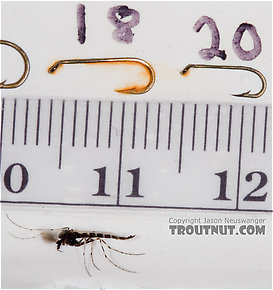Blog & Latest Updates
Fly Fishing Articles
Insects by Common Name


> > chironomids-East versus West
The Specimen
Stictochironomus Midge Adult View 11 PicturesThis midge and several like it, including a female I also photographed, hatched from larvae which were living in some fine mud I'm using as substrate in my bug-rearing aquarium.
View 11 PicturesThis midge and several like it, including a female I also photographed, hatched from larvae which were living in some fine mud I'm using as substrate in my bug-rearing aquarium.
 View 11 PicturesThis midge and several like it, including a female I also photographed, hatched from larvae which were living in some fine mud I'm using as substrate in my bug-rearing aquarium.
View 11 PicturesThis midge and several like it, including a female I also photographed, hatched from larvae which were living in some fine mud I'm using as substrate in my bug-rearing aquarium.Collected April 10, 2007 from Mystery Creek #62 in New York
Added to Troutnut.com by on April 10, 2007
Added to Troutnut.com by on April 10, 2007
The Discussion
| Joec | March 21st, 2008, 11:54 am | |
| portsmouth, nh Posts: 8 | Spring can't arrive soon enough...after ice-out streamer fishing and before the high water levels on moving water venues become more reasonable, I love to fish chironomid imitations in ponds. In ponds containing few forage fish, this begins before the ice goes out entirely. My question is simple: why are chironomid species in the East so much smaller than out West? I have fished the Kamloops area of BC which is, of course, world renown for huge (size and quantity)chironomid hatches and the difference is unbelievable. I suspect it has to do with lack of fertility in my home waters, still or otherwise. Can anyone help? | |
| Taxon | March 21st, 2008, 12:59 pm | |
Site Editor Royse City, TXPosts: 1350 | Joe- There are ~189 genera and ~1233 species of family Chironomidae in North America. My belief is, the extremely large chironomid species referred to as "Bombers" in British Columbia are not present in eastern North America. Of course, this begs the question, why not? And, although I really don't know for certain, I would speculate that, the unique combination of geology and climate they require is simply not found in the East. | |
| Best regards, Roger Rohrbeck www.FlyfishingEntomology.com | ||
| Sayfu | August 12th, 2012, 5:06 pm | |
| Posts: 560 | Bombers? I had the notion they were called "buzzers", but my memory is terrible. Anyway, I find them in a wide range of sizes out here in Idaho. Biguns, and very small ones in lakes . And the colors of pupa that anglers have success with during a days fishing is quite mind boggling. One guy in a float tube tells me he landed 26 on a #18 bright red pupa the week before. I went home and tied up lots of bright little red ones, and went back and got skunked. Some days they are touting purple ones. Wish I could keep it simple. | |
| Taxon | August 12th, 2012, 6:09 pm | |
Site Editor Royse City, TXPosts: 1350 | Hi Jere-Chironomid pupae range from under 1/8" to over 1 inch in length; the nickname "bomber" refers to the larger pupae. Phillip Rowley, BC & AB author of Fly Patterns for Stillwaters: A study of Trout, Entomology and Tying, page 11. I believe "buzzers" to be the common name used in England for Chironomids (members of family Chironomidae). | |
| Best regards, Roger Rohrbeck www.FlyfishingEntomology.com | ||
Quick Reply
You have to be logged in to post on the forum. It's this easy:
Related Discussions
| Title | Replies | Last Reply |
| Re: NC Cream Adult Chironomid help :) In the Identify This! Board by CouxJoe | 5 | Jun 22, 2012 by Falsifly |
| Re: Check out this very unusual trout In General Discussion by Wbranch | 6 | Nov 12, 2014 by PaulRoberts |
| Re: GD Shuck In the Mayfly Species Ephemera guttulata by Martinlf | 10 | Jun 2, 2013 by Crepuscular |
| Re: Taxonomy question In the Mayfly Family Leptohyphidae by Doublezz105 | 3 | Oct 30, 2009 by Doublezz105 |
| The Second Annual Hardy Cup Bamboo Rodcasting Competition. In General Discussion by Flymom | 0 | |
| Re: migrating brookies? In General Discussion by Brooklover | 3 | Jul 26, 2012 by Oldredbarn |
| Re: Midge Sizes In General Discussion by Lastchance | 7 | Jan 9, 2009 by DSFlyman |
| Re: Olives In General Discussion by Martinlf | 1 | Mar 14, 2021 by Wiflyfisher |
| Re: Dragon fly In the Identify This! Board by Fredw | 9 | Aug 22, 2013 by Taxon |
| Re: Chrysops callidus In Fly Tying by FredH | 6 | May 31, 2011 by Jmd123 |
Troutnut.com is copyright © 2004-2024 Jason
Neuswanger (email Jason). See my FAQ for information about use of my images.
 privacy policy
privacy policy

